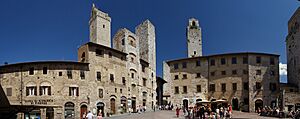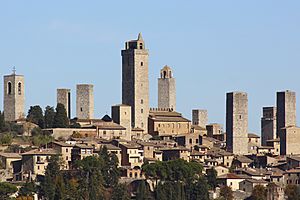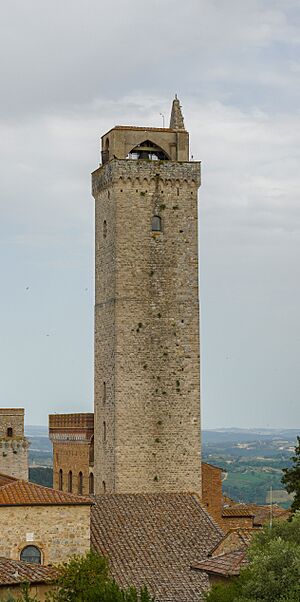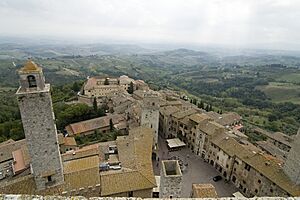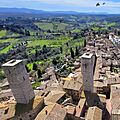San Gimignano facts for kids
Quick facts for kids
San Gimignano
|
||
|---|---|---|
| Comune di San Gimignano | ||
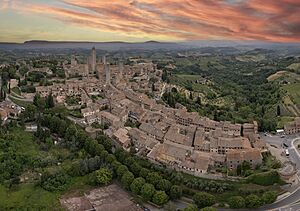
Aerial view of the town
|
||
|
||
| Country | Italy | |
| Region | Tuscany | |
| Province | Siena (SI) | |
| Frazioni | Badia a Elmi, Castel San Gimignano, Pancole, San Donato, Santa Lucia, Ulignano | |
| Area | ||
| • Total | 138 km2 (53 sq mi) | |
| Elevation | 324 m (1,063 ft) | |
| Population | ||
| • Total | 7,780 | |
| • Density | 56.38/km2 (146.0/sq mi) | |
| Demonym(s) | Sangimignanesi | |
| Time zone | UTC+1 (CET) | |
| • Summer (DST) | UTC+2 (CEST) | |
| Postal code |
53037
|
|
| Dialing code | 0577 | |
| Patron saint | St. Geminianus, Saint Fina | |
| Saint day | 31 January, 12 March | |
San Gimignano (pronounced san jee-mee-NYAH-noh) is a small, ancient town in the Tuscany region of Italy. It's famous for its tall, old towers and strong walls. People often call it "the Town of Fine Towers."
This town looks like it's from the Middle Ages because it has kept many of its original buildings. Its unique skyline, with many towers on a hilltop, is truly unforgettable. Inside the walls, you can see amazing examples of old Romanesque and Gothic buildings, including churches and homes.
The town's main church, the Collegiate Church, and the Church of Sant' Agostino have beautiful paintings called frescos. These paintings are very old, from the 1300s and 1400s. Because of its well-preserved history, the "Historic Centre of San Gimignano" is a special place recognized by UNESCO.
San Gimignano is also known for its delicious local products. These include saffron, a special spice, a unique kind of ham called Golden Ham, pecorino cheese, and a white wine called Vernaccia di San Gimignano. This wine is made from a very old type of grape grown on the hills around the town.
Contents
Exploring San Gimignano's Location
The town of San Gimignano covers an area of about 138 square kilometers (53 square miles). It sits on a hill in a valley called Val d'Elsa. The land here goes from a low point of 64 meters (210 feet) above sea level near the Elsa River to a high point of 631 meters (2,070 feet) in the Cornocchio area.
A Journey Through San Gimignano's Past
Long, long ago, around 300 BC, an ancient Etruscan village stood where San Gimignano is today. Later, in the 1st century, two Roman brothers, Muzio and Silvio, built castles here.
The town's name changed to San Gimignano in 450 AD. This happened after a saint named Geminianus, who was a bishop, helped save the castle from being destroyed by Attila the Hun's followers. Because of this, a church was built for the saint. Over time, a walled village grew around it. From the year 929, the bishops of Volterra ruled the town.
During the Middle Ages and the Renaissance, San Gimignano was an important stop for Catholic travelers. These pilgrims were on their way to Rome and the Vatican, as the town was located on the famous Via Francigena road. The town also grew rich from trading farm products from its fertile hills. Two very important products were saffron, used for cooking and dyeing cloth, and Vernaccia wine. People said this wine even inspired popes and poets!
In 1199, the town became independent from the bishops of Volterra. It started building its own churches and public buildings. However, the town faced many conflicts for the next two centuries. There were fights between two powerful groups, the Guelphs and Ghibellines, and also rivalries between families within San Gimignano.
These family rivalries led to a unique building competition. Families started building taller and taller tower houses to show off their power. At one point, there were 72 tower houses, some as tall as 70 meters (230 feet)! To stop this competition, the local council decided that no new tower could be taller than the one next to the Palazzo Comunale.
Even though Saint Geminianus is the town's official patron saint, San Gimignano also honors Saint Fina. She was born in the town in 1238. Her special day is March 12. You can see her shrine and beautiful frescos by Ghirlandaio in the Chapel of Santa Fina inside the Collegiate Church. The house believed to be hers is still in the town.
On May 8, 1300, the famous poet Dante Alighieri visited San Gimignano. He was there as an ambassador for a group called the Guelph League in Tuscany.
The town was very successful until 1348. That year, the terrible Black Death spread across Europe, and about half of San Gimignano's people died. After this, the town came under the rule of Florence. Some new buildings were built in the Florentine style, and many of the tall towers were made shorter. After that, the town didn't change much. This helped San Gimignano stay preserved in its medieval state until the 1800s, when people started to see it as a special place for tourists and art lovers.
Discovering San Gimignano's Layout
| UNESCO World Heritage Site | |
|---|---|
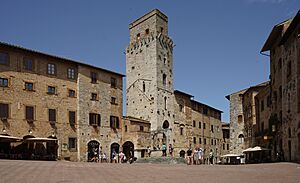 |
|
| Criteria | Cultural: i, iii, iv |
| Inscription | 1990 (14th Session) |
| Area | 13.88 ha |
The city is built on a long hill, running from north to south. It has three strong walls around it. At its highest point, on the west side, are the remains of an old fortress. This fortress was taken apart in the 1500s.
There are eight entrances into the city, all part of the second wall built in the 1100s and 1200s. The main gates are Porta San Giovanni to the south, Porta San Matteo to the northwest, and Porta S. Jacopo to the northeast. The two main streets, Via San Matteo and Via San Giovanni, go through the city from north to south.
In the center of town are four important squares: Piazza Duomo, where the Collegiate Church stands; Piazza della Cisterna; Piazza Pecori; and Piazza delle Erbe. To the north, there's another important square, Piazza Agostino, with the Church of Sant' Agostino. These two main churches and their squares divide the town into two parts.
Main Sights to See
San Gimignano has many beautiful examples of Romanesque and Gothic architecture. You can tell them apart by their arches: Romanesque buildings have round arches, while Gothic buildings have pointed arches. Besides churches and old forts, there are also many Romanesque homes.
A special feature you'll see in this area is that the arches over doorways are often a bit flattened. Sometimes, a doorway has a smaller, low arch under a bigger semi-circular or pointed arch. Both Romanesque and Gothic windows sometimes have two openings divided by a stone pillar, all under one arch. You can see a detailed model of the city from the 1300s at the SanGimignano1300 museum.
Town Squares to Explore
Piazza della Cisterna
This square is the main one in San Gimignano. You enter it from Via San Giovanni. It's shaped like a triangle and surrounded by medieval houses from different time periods. Some of these are beautiful examples of Romanesque and Gothic palaces.
In the middle of the square is a well. This well was the main source of water for the town's people. The well structure was built in 1346. While much of it has been fixed up recently, parts of the paving stones are from the 1200s!
Piazza Duomo
This square is just north of Piazza della Cisterna. You can reach it through a passage next to an open walkway. On the west side, at the top of the square, is the Collegiate Church. You reach it by climbing a wide set of steps.
The name of the square might make you think this church was once a cathedral, but it wasn't. Other important buildings here include the Palazzo Comunale and the Palazzo Podesta. The Palazzo Podesta was the home of the mayor and has a very large arched walkway.
Famous Towers of San Gimignano
Many cities, like Florence, lost most of their old towers due to wars or new building projects. But San Gimignano has managed to keep fourteen of its towers! These towers are of different heights and are what make the town famous around the world.
Here are some of the towers you can see:
- Campanile della Collegiata (Bell Tower of the Collegiate Church)
- Torri degli Ardinghelli (Ardinghelli Towers)
- Torre dei Becci (Becci Tower)
- Torre Campatelli (Campatelli Tower)
- Torre Chigi (Chigi Tower), built in 1280
- Torre dei Cugnanesi (Cugnanesi Tower)
- Torre del Diavolo (Devil's Tower)
- Torre Ficherelli or Ficarelli (Ficherelli Tower)
- Torre Grossa (Great Tower), built in 1311, stands 54 meters (177 feet) tall
- Torre di Palazzo Pellari (Pellari Palace Tower)
- Casa-torre Pesciolini (Pesciolini House-Tower)
- Torre Pettini (Pettini Tower)
- Torre Rognosa (Rognosa Tower), 51 meters (167 feet) tall
- Torri dei Salvucci (Salvucci Towers)
Important Churches
The town has many churches. The two most important are the Collegiata (Collegiate Church) and Sant'Agostino (Church of Saint Augustine). Both have many beautiful artworks by early Italian Renaissance artists.
In the nearby village of Cèllole, you can find the Pieve di Santa Maria. This is a Romanesque country church with a special area for baptisms.
Civic Buildings and Art
The Communal Palace used to be where the mayor worked. Today, it's home to the town's art gallery. Here, you can see paintings by famous artists like Pinturicchio, Benozzo Gozzoli, Filippino Lippi, and others.
From a room called Dante's Hall in the palace, you can see a large painting called a Maesta by Lippo Memmi. You can also go up the Torre del Podestà, also known as Torre Grossa. This tower was built in 1311 and is 54 meters (177 feet) high.
San Gimignano in Culture
San Gimignano is the birthplace of a poet named Folgore da San Gimignano (1270–1332).
- A made-up version of San Gimignano appears in E. M. Forster's 1905 book, Where Angels Fear to Tread. In the book, it's called Monteriano.
- The famous artist M. C. Escher created a woodcut picture of San Gimignano in 1923, showing its well-known towers.
- Director Franco Zeffirelli used San Gimignano to look like the town of Assisi in his 1972 movie about Saint Francis of Assisi, called Brother Sun, Sister Moon. Most of the "Assisi" scenes were filmed here.
- Part of the 1999 movie Tea with Mussolini was filmed in San Gimignano. This drama is about British and American women living in Italy during World War II. The movie shows the women saving frescos in the Duomo (the main church) from being destroyed during the war. While the movie scene is mostly fictional, the town did face risks during the war.
- In the 2005 book The Broker by John Grisham, a character named Joel Backman rents an old monastery near San Gimignano for a month.
- A version of the town from the 1400s is featured in the 2009 video game Assassin's Creed II.
Population Changes Over Time
| Historical Population of San Gimignano |
|
EasyTimeline 1.90
|
San Gimignano's International Friends
San Gimignano has special partnerships with other towns around the world. These are called "twin towns" or "sister cities."
 Český Krumlov, Czech Republic
Český Krumlov, Czech Republic Meersburg, Germany
Meersburg, Germany Mestia, Georgia
Mestia, Georgia
Panoramic Views of San Gimignano
Images for kids
See also
 In Spanish: San Gimignano para niños
In Spanish: San Gimignano para niños



